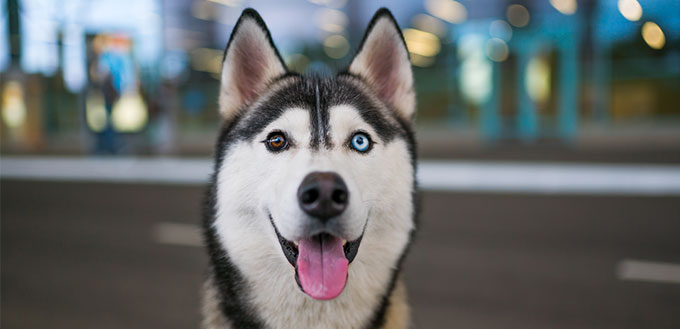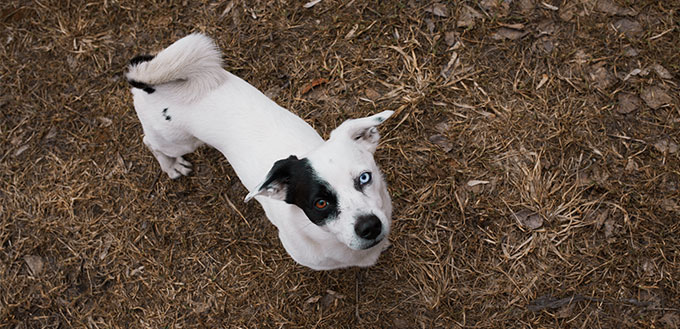Have you noticed that a small number of dogs have eyes that are different colors? It’s a mesmerizing and beautiful look. The cause is a medical condition called heterochromia and it does not just occur in dogs. The late David Bowie also had this stunning condition!
Most dogs have brown eyes but some have a variation of the brown color. This can appear as a golden color or as an amber color. A small proportion of dogs have blue eyes and an even smaller number have one of each. This condition is called heterochromia iridis. In the past, this stunning phenomenon was highly treasured and revered. The Native American people believed that dogs with heterochromia could see all things on heaven and earth. They called the condition ”ghost eyes”. Read on to find out all you ever wanted to know about this fascinating condition.
What Causes Heterochromia in Dogs?
The colored part of the eye is called the iris and the pleural is irides. It is a thin and circular structure that controls how large the pupil is and therefore is essential for moderating the amount of light that enters the eye.
There is a lot of pigment (natural color) in the iris and the shades can be brown, hazel, green, gray, or blue. Even though the range of colors is wide, the only pigment involved is melanin. The amount of melanin and the type of melanin in the eye, determine what color the iris will be. In dogs that have eyes of different colors, it is most often caused by a variation in melanin between the eyes. If too much melanin is present it is called hyperchromic and if too little melanin is present it is called hypochromic
Most dogs have brown eyes and these have a lot of pigment. Dogs with blue eyes actually have a genetic mutation which decreases the amount of melanin and changes the color of the iris from brown to blue.
Heterochromia is most often a genetic condition which means that it is caused by the DNA of the dog and not triggered by an injury or a disease. Scientists do not yet completely understand how this happens but it is not confined to canines. You will find horses, cats and humans with two colored eyes.
Where heterochromia is caused by genetics, the condition will be present from birth. This is called congenital heterochromia. Occasionally, an injury or illness can cause the change in pigmentation and this is called acquired heterochromia.
There are different degrees of heterochromia. If the eyes are completely different colors it is called complete heterochromia. Sometimes, there is just a part of one of the eyes that is a different color but they also share a color. This is called partial, incomplete or sectoral heterochromia. A typical example is to have both irises blue but one with a brown spot in it. In a version of the condition that is called central heterochromia, the iris looks as if it has spikes in it or as if it has a halo. This looks amazing!
Heterochromia and Dog Breeds
There are several dog breeds with different colored eyes – it can happen in any breed but is more common in some. Dog breeders are well aware of this and genetic experts support that conclusion. It is common to see this trait running through several generations of the same dog family as it is passed along. If you decide to breed from your heterochromic dog you are more likely to have heterochromic pups!
Complete heterochromia is seen most often in Australian Cattle Dogs, Dalmatians, Australian Shepherds and Siberian Huskies. Whereas, sectoral and central heterochromia is often seen in Border Collies, Chihuahuas and Catahoula Leopard Dogs. It is also seen in Dachshunds, Siberian Huskies, Dalmatians, Great Danes, Shetland Sheepdogs and Shih Tzus. It is also fairly common in Alaskan Malamutes, Beagles and Welsh Corgis.
Husky heterochromia is particularly common and there is a suggestion that it is linked to sight problems because about 8-10% of the husky population have hereditary eye conditions also. Husky pups have a change in eye color as they grow and mature. They are all born with blue eyes and some stay that way. Others have a change to brown eyes at about five to eight weeks of age. Most pups will have a settled eye color by the time they are three to four months of age but in some it can be delayed until they are up to six months of age.
There is on-going research to try to establish if dog breeds with different colored eyes have particular genetic mutations but there are no definite answers yet. It is thought that there is a connection with coat color and possibly with genetic-based conditions such as deafness.
Myths and Truths About Heterochromia
It is understandable to be concerned about the eyesight of a dog with heterochromia but these concerns are largely unfounded. Having said that, it is important to state that if you spot that the color of your dog’s eyes has changed or if your dog seems to have discomfort or pain around their eyes, you should get them checked out by your vet.
There are many myths surrounding canine heterochromia; some are complete nonsense and some are based on partial truth. Here are the most popular ones that you may have come across.
Heterochromia Can Develop as a Dog Gets Older
There are some medical issues that can cause color changes in the eye and these include cataracts, glaucoma and uveitis. Other potential culprits are corneal dystrophy and nuclear sclerosis. It can also be caused by retinal dysplasia and an underdeveloped optic nerve. All of these can develop as your dog gets older. Your vet will be able to advise you on the best treatment and on how to care for a dog with these conditions.
In some breeds, both eye and coat color can change as a puppy grows. Puppies born with blue eyes can become adults with brown eyes. This is not heterochromia, because both eyes are the same color.
Heterochromia Is a Sign of Genetic Problems in a Breed
There are some concerns that the presence of canine heterochromia may indicate that there is a lack of genetic diversity within a breed. This means that too many dogs have genes that are too similar. The practice of pure breeding dogs has led to a limited gene pool in many cases and this can lead to genetic defects and associated health problems. It is known that the breeds most often affected by heterochromia do have limited gene pools so there is likely to be some truth in this. Interestingly, in the Dalmatian breed, females are affected more often than males.
Heterochromia Is Linked to Coat Pattern
Dogs that have a piebald or merle color pattern on their coats have an irregular distribution of melanin. They also have a higher incidence of heterochromia. Whilst this does not cause any health problems, it is an interesting association and may lead to further research into the causes of heterochromia.
Dogs With Heterochromia Are Deaf
There is a myth that all dogs with two colored eyes are deaf and this is not at all true. However, there is some evidence to suggest that Dalmatians that have partial or sectoral heterochromia are more likely to have impaired hearing. It is thought that the gene that causes the piebald or merle color also controls deafness and heterochromia so the three things are connected.
Dogs With Heterochromia Are Blind
The vision of dogs with heterochromia is not impaired, they can still see perfectly well out of both eyes. However, there is a condition called acquired heterochromia where an eye injury or foreign body has caused a loss of eyesight as well as a change in the color of the iris.
Heterochromia Only Appears in the Eyes
Other parts of the body can be affected. You may notice that dogs with this condition also have two different colors on their nose but this does not affect their health at all. There is also a connection with coat color. Breeders have noticed that dogs with a merle, dapple or white coat and those with an increase in white patterns around their head are more likely to have the condition.
Heterochromia Is Painful
Your dog will not suffer pain because they have heterochromia. Having said that, there is some research that indicates that dogs with heterochromia have a greater sensitivity to light. This is especially pronounced in the lighter colored eye because it will have less melanin. Less light can be blocked and it will reach the retina where it can cause damage. This can feel quite uncomfortable for your pooch.
You can do a lot to help this. You can keep your dog inside on very bright days and if they do go out, keep them away from bright sunlight. Perhaps you could take them out for a walk at dawn and dusk rather than at midday.
Alternatively, you could buy them some dog shaded goggles or sunglasses that are designed just for dogs. They will also look so cool!
Dogs With Heterochromia Have Suffered an Eye Injury
This is not often true because most cases are genetic. However, it can be true with some injuries. When this happens it is called acquired heterochromia. Trauma caused to the eye or to the delicate area around the eye, can cause bleeding and swelling inside the structure of the eye. This, in turn, can lead to a change in the color of the iris and sadly this can be permanent. If your dog is unlucky enough to get a foreign object stuck in the surface of their eye, this can also lead to heterochromia as well as eyesight problems. It is important that you see a vet right away.
Illness Causes Heterochromia
It is true that some illnesses and conditions are connected with acquired heterochromia. These include internal toxicity, inflammation and infection. Illnesses that can change your dog’s eye color include glaucoma, melanoma of the eye, eye tumors, iris ectropion, uveal eye disease, ocular disease, optic nerve hypoplasia, retinal dysplasia, microphthalmia, uveal coloboma and diabetes. If your dog’s eyes start to develop a blue haziness, it can be a sign of cataracts or corneal dystrophy and you need to see your vet.
It is also true that some medications can cause the color of one eye to change and for a dog to develop heterochromia. The most likely culprit is a medication used to treat glaucoma in dogs.
The Last Word
Having a dog with different colored eyes is very special. They are uniquely beautiful and you won’t be able to stop gazing at them. Most of the time it is caused by a genetic mutation and does not cause any further health issues. You may need to be careful with them in bright sunlight and keep a look out for hearing problems but most dogs will be absolutely fine.
The situation is different if your dog develops a change of eye color in one eye when they are older. This can mean that they have an injury or an illness and they may be in discomfort or pain. You may notice other symptoms to indicate that you dog is distressed. If this happens it is essential that you take your pooch to the vet right away to get the issue investigated.
You may also like our article on the top 10 Tricolor Dog Breeds.
Note: The advice provided in this post is intended for informational purposes and does not constitute medical advice regarding pets. For an accurate diagnosis of your pet's condition, please make an appointment with your vet.









